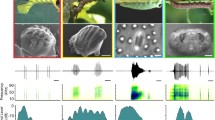Summary
-
1.
Many insects stridulate when they are handled or attacked. It has been suggested that this disturbance stridulation acts to deter predators. This hypothesis was investigated in a series of experiments. Predators were given insects which had been silenced by disruption of their sound-producing mechanism or else had been sham operated but retained their normal ability to stridulate.
-
2.
Three types of insects (mutillid wasps, Dasymutilla spp.; water scavenger beetles, Tropisternus spp.; and round sand beetles, Omophron labiatus) were given to wolf spiders (Lycosa ceratiola and Geolycosa ornatipes) at night in the field under natural conditions. When attacking silenced insects, spiders displayed greater persistence than when attacking phonic insects (Table 1). In addition, mortality was greater among silenced insects.
-
3.
Spiders (L. ceratiola) were also given an artificial ‘insect’—a vibrating probe whose vibration mimicked that of the cuticle of a stridulating insect. As with real insects, spiders persisted longer in their attack on the probe when it was silent than when it was ‘stridulating”.
-
4.
Female mutillid wasps were given to wild-caught mice (Peromyscus floridanus) in the laboratory. Unsilenced mutillids survived the encounter more often than their silenced counterparts. In another experiment, the stings of mutillid wasps were removed before testing. Mice killed nearly all these ‘unprotected’ mutillids. However, it took mice significantly longer to attack unsilenced mutillids and longer to kill them after initiating the assault (Table 2).
-
5.
These results support the view that insect disturbance stridulation deters predators. Two modes of action by which these sounds may have their effect are discussed: they may serve to startle the attacker or they may alert it to the potential harmfulness of the insect and as such may qualify as an example of acoustic aposematism.
Similar content being viewed by others
References
Alexander, A.J.: On the stridulation of scorpions. Behaviour 12, 339–352 (1958)
Alexander, R.D.: Acoustical communication in arthropods. Annu. Rev. Entomol. 12, 494–526 (1967)
Barth, F.G.: Ein einzelnes Spaltsinnesorgan auf dem Spinnentarsus: seine Erregung in Abhängigkeit von Parametern des Luftschallreizes. Z. Vergl. Physiol. 55, 407–449 (1967)
Bauer, T.: Experimente zur Frage der biologischen Bedeutung des Stridulationsverhaltens von Käfern. Z. Tierpsychol. 42, 57–65 (1976)
Blest, A.D.: The function of eyespot patterns in the Lepidoptera. Behaviour 11, 209–256 (1957)
Claridge, M.F.: Stridulation and defensive behaviour in the ground beetle Cychrus caraboides (L.). J. Entomol. [A] 49, 7–15 (1974)
Conner, W.E., Masters, W.M.: Infrared video viewing. Science 199, 1004 (1978)
Darwin, C.: The descent of man and selection in relation to sex, 2nd ed., p. 311. New York: Appleton 1874
Dumortier, B.: L'Émission sonore dans le genre Gromphadorhina Brunner (Blattodea, Perisphaeriidae), étude morphologique et biologique. Bull. Soc. Zool. Fr. 90, 89–101 (1965)
Dunning, D.C.: Warning sounds of moths. Z. Tierpsychol. 25, 129–138 (1968)
Dunning, D.C., Roeder, K.D.: Moth sounds and the insect catching behavior of bats. Science 147, 173–174 (1965)
Edmunds, M.: Defence in animals: A survey of anti-predator defences. Harlow, Essex: Longman 1974
Eisner, T., Aneshansley, D., Eisner, M., Rutowski, R., Chong, B., Meinwald, J.: Chemical defense and sound production in Australian tenebrionid beetles (Adelium spp.). Psyche 81, 189–208 (1974)
Frings, E., Frings, M.: Reactions of orb-weaving spiders (Argiopidae) to airborne sounds. Ecology 47, 578–588 (1966)
Guthrie, D.M.: Sound production and reception in a cockroach. J. Exp. Biol. 45, 321–328 (1966)
Haskell, P.T.: Insect sounds. Chicago: Quadrangle Books 1961
Liesenfeld, F.J.: Über Leistung und Sitz des Erschütterungssinnes von Netzspinnen. Biol. Zentrabl. 80, 465–476 (1961)
Lesser, F.C.: Insectotheologia, p. 314. Frankfurt and Leipzig: Michael Blochberger 1738
McCue, J.J.G., Bertolini, A.: A portable receiver for ultrasonic waves in air. IEEE Trans. Sonics Ultrason. SU-11, 41–49 (1964)
Marshall, G.A.K.: Experimental evidence of terror caused by the squeak of Acherontia atrops. Trans. R. Entomol. Soc. Lond., 402 (1902a)
Marshall, G.A.K.: Insect stridulation as a warning or intimidating character. Trans. R. Entomol. Soc. Lond., 404 (1902b)
Masters, W.M.: Irradiance modulation used to examine sound-radiating cuticular motion in insects. Science 203, 57–60 (1979)
Pocock, R.I.: How and why scorpions hiss. Nat. Sci. (Lond.) 9, 17–25 (1896)
Schildknecht, H., Maschwitz, U., Winkler, H.: Zur Evolution der Carabiden-Wehrdrüsensekrete. Naturwissenschaften 55, 112–117 (1968)
Schmidt, J.O., Blum, M.S.: Adaptations and responses of Dasymutilla occidentalis (Hymenoptera: Mutillidae) to predators. Entomol. Exp. Appl. 21, 99–111 (1977)
Siegel, S.: Nonparametric statistics for the behavioral sciences. New York-Toronto-London: McGraw Hill 1956
Smith, R.L., Langley, W.M.: Cicada stress sound: An assay of its effectiveness as a predator defense mechanism. Southwest. Nat. 23, 187–196 (1978)
Snedecor, G.W., Cochran, W.G.: Statistical methods, 6th ed. Ames, Iowa: Iowa State University 1967
Walcott, C.: A spider's vibration receptor: Its anatomy and physiology. Am. Zool. 9, 133–144 (1969)
Wheeler, J.W., Chung, R.H., Oh, S.K., Benfield, E.F., Neff, S.E.: Defensive secretions of cychrine beetles (Coleoptera: Carabidae). Ann. Entomol. Soc. Am. 63, 469–471 (1970)
Winking-Nikolay, A.: Untersuchungen zur Bio-Akustik des Waldmistkäfers, Geotrupes stercorosus Scriba. Z. Tierpsychol. 37, 515–541 (1975)
Author information
Authors and Affiliations
Rights and permissions
About this article
Cite this article
Mitchell Masters, W. Insect disturbance stridulation: Its Defensive role. Behav Ecol Sociobiol 5, 187–200 (1979). https://doi.org/10.1007/BF00293305
Received:
Issue Date:
DOI: https://doi.org/10.1007/BF00293305




